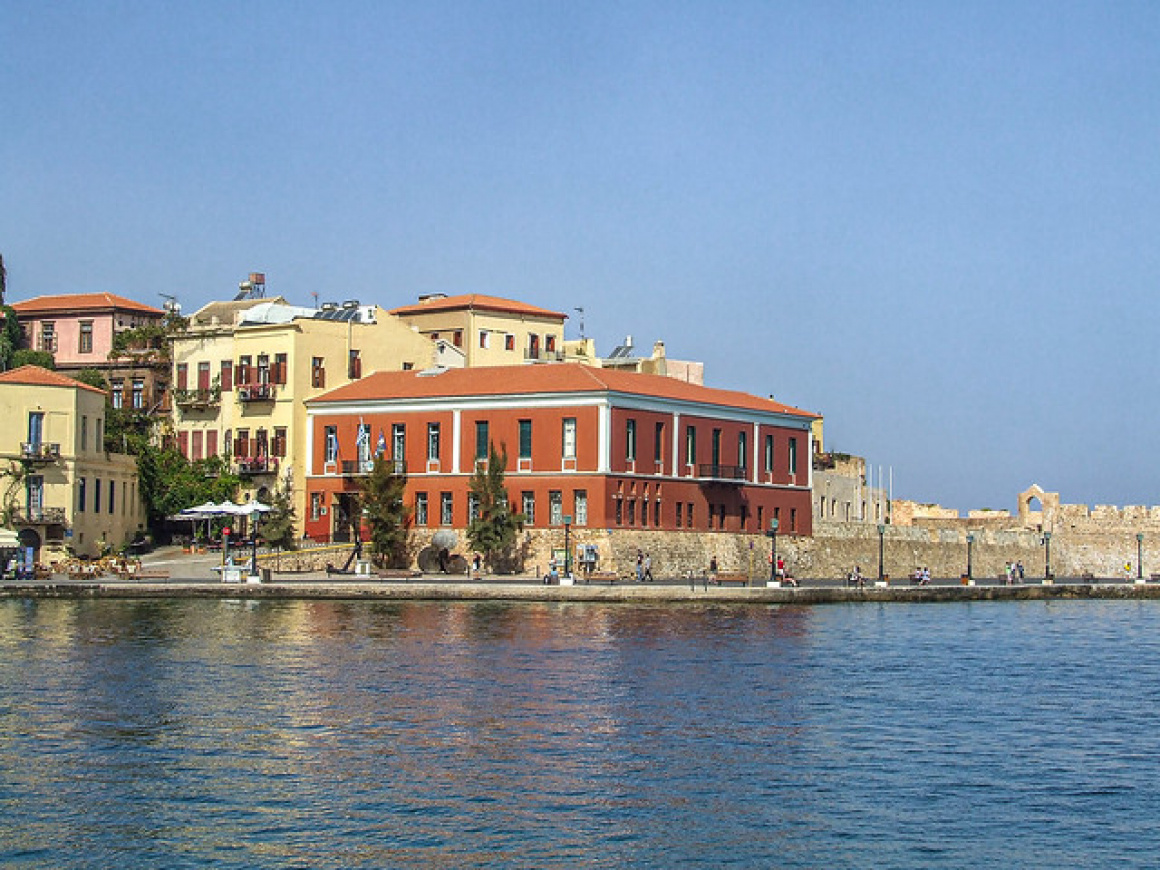Chania, with its picturesque Venetian harbour and deep naval history, is home to the fascinating Maritime Museum of Crete. Tucked at the entrance of the Firkas Fortress on the harbour's west side, this museum (in Greek often called Nautiko Mousio) is a tribute to Crete's seafaring heritage – from ancient times through the Byzantine and Venetian periods, to the modern Greek Navy and the Battle of Crete in WWII. For anyone intrigued by ships, naval battles, or even just Chania's history, the Maritime Museum is a must-visit. It offers an engaging mix of meticulously crafted ship models, historical naval artefacts, maps, photographs, and interactive exhibits. While relatively small, it is richly packed with content, thoughtfully laid out over two floors. What's special is how personal some exhibits feel: many items were donated by Cretan sailors or their families, giving a real human touch to naval history. Whether you're a naval buff or not, you'll come away with a deeper appreciation of how the sea has shaped Crete's destiny and how Cretans have, in turn, left their mark on maritime affairs.
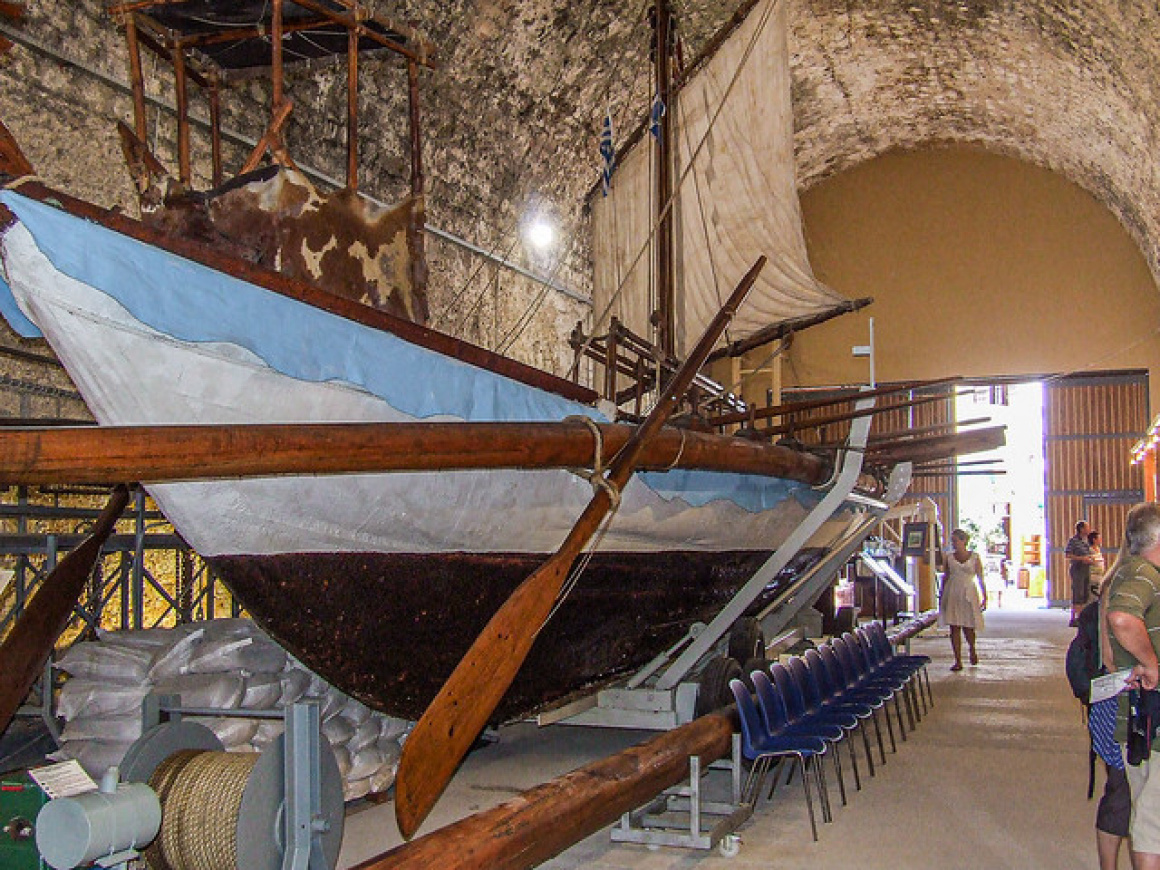
 'Chania Maritime Museum of Crete' - Attribution: www.mgaylard.co.uk and thanks for looking
'Chania Maritime Museum of Crete' - Attribution: www.mgaylard.co.uk and thanks for lookingCharting the Seas of History
The museum's narrative flows chronologically. As you walk in, you are effectively boarding a ship that will sail you through the ages of Cretan maritime history.
Ancient and Classical Era Navigation
The journey starts with Crete's earliest maritime activity. You might see models of Minoan ships (often depicted on seals and frescoes), with their high prows and oars – Crete had the first navy in Europe, according to some historians, projecting power in the Aegean as early as 2000 BC. There's likely reference to the myth of King Minos dominating the seas (Thucydides wrote of Minos' thalassocracy). You may see reproductions of ancient ship frescoes (like the one from Akrotiri Thera of ships, to stand in for what Minoan fleets looked like).

 'Wooden Ship with Oars' - Attribution: mikecogh
'Wooden Ship with Oars' - Attribution: mikecoghByzantine and Arab Period
Moving forward, a highlight is a detailed model of a Greek trireme – those triple-banked war galleys of Classical Greece. Crete itself was not a major naval power then, but Cretans served as mercenaries and pirates. The museum might include references to famous sea battles near Crete's shores in Hellenistic and Roman times. In the medieval period, the museum covers Crete's naval story, including the rise of piracy in the Mediterranean. The island's strategic position made it both a target and base for pirates. For instance, the Saracen Arab fleet that conquered Crete in 824 AD – the museum might have dioramas or maps showing how Arabs turned Crete into a pirate emirate until the Byzantines reconquered it in 961. There could be an array of Byzantine-era amphorae recovered from shipwrecks around Crete, telling of trade cargoes such as wine and olive oil, along with diving equipment showcases or underwater finds like anchors from local waters.
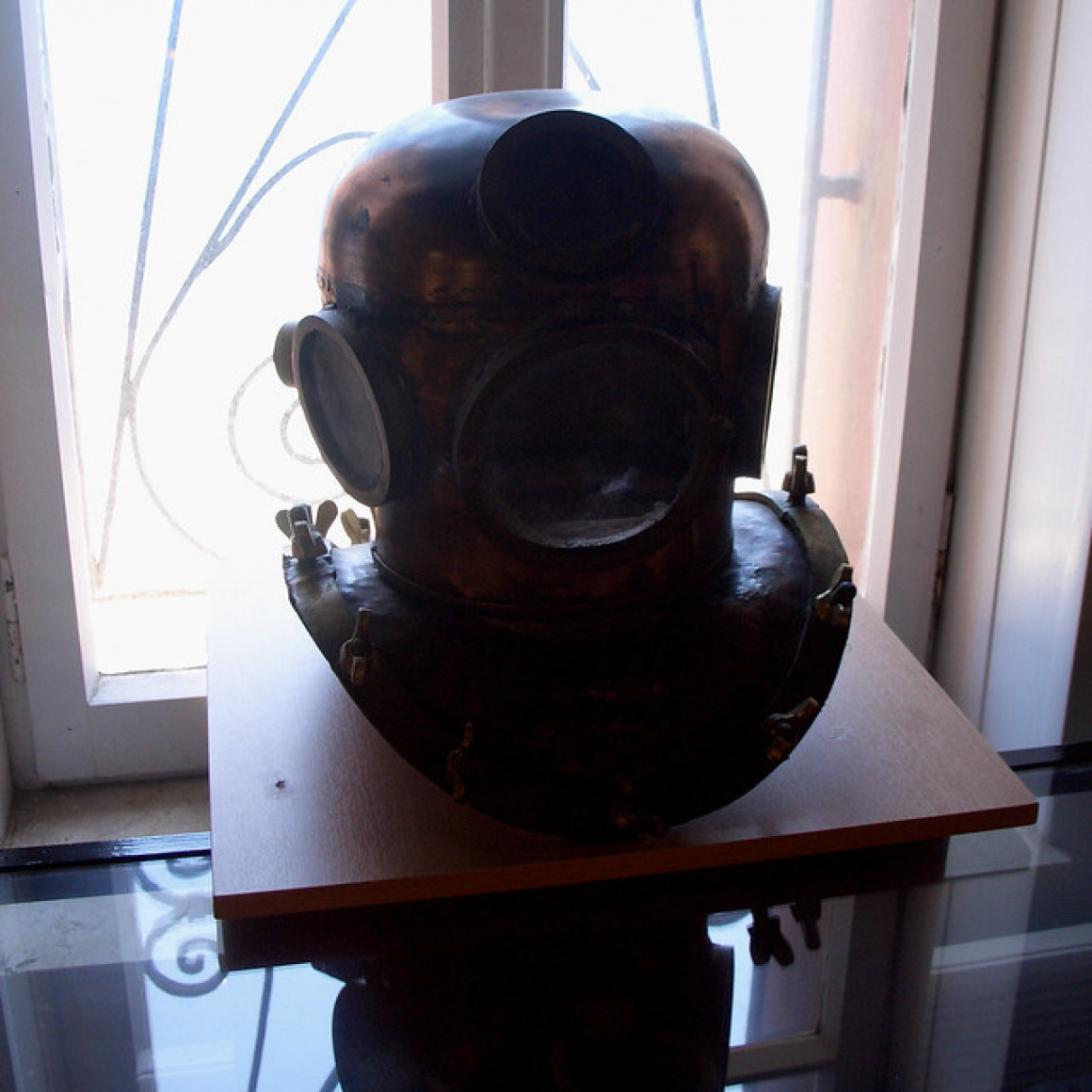
 '1930s diving helmet' - Attribution: currybet
'1930s diving helmet' - Attribution: currybetVenetian Naval Might
A large part of Chania's maritime glory came under Venetian rule (1204-1669). The museum shines in this period, displaying:
The fortifications and shipyards in Chania are also touched on: for example, the Venetian arsenals (Neoria) which still stand at the harbour, where galleys were built – maybe the museum has a wooden model of one of the Neoria with a half-built galley inside to illustrate. One corner likely honours the maritime traditions in daily life – for example, the role of sponge diving (Crete had sponge divers like those from Kalymnos), or historical fishing techniques (the typical Cretan fishing boat type trechantiri might have a model).
Ottoman Period & 1821 War
The Ottoman era, while not known for Crete's naval strength (the Ottomans restricted local shipbuilding), still features episodes such as Cretan participation in the Greek War of Independence (1821-29). One panel probably narrates the story of how Cretan revolutionaries tried to obtain supplies by sea. Possibly, there is even a model of a fireship (the brulotte) as used by Greek naval heroes like Kanaris, as many Cretans served in the nascent Greek state's navy.
20th Century – Modern Greek Navy and World War II
The second floor often covers modern times. This includes the Balkan Wars and the Greco-Turkish War (1912-22), with photos or uniforms of Cretan sailors who served then. A significant section is dedicated to World War II – especially the Battle of Crete (1941). A diorama of Souda Bay under attack may be featured, as it was a key Allied naval base with ships sunk by German bombers. There might be recovered items from those ships, such as shell casings or pieces of a ship's hull. Possibly, a display about the HMS York (a British cruiser scuttled in Souda Bay) or the Greek destroyer “Vasilissa Olga” that operated from Crete is included. The museum also recounts tales of resistance and the navy during occupation, highlighting how some Cretans escaped to join the Allied navies and others used small vessels to smuggle people out. A notable exhibit could be a letter or logbook from Operation Abstention or the Dodecanese campaign, especially given Souda's role. In post-WWII times, the museum often has model ships of modern frigates and destroyers, along with tributes to Crete-born naval figures, such as Vice Admiral Konstantinos Giannopoulos.
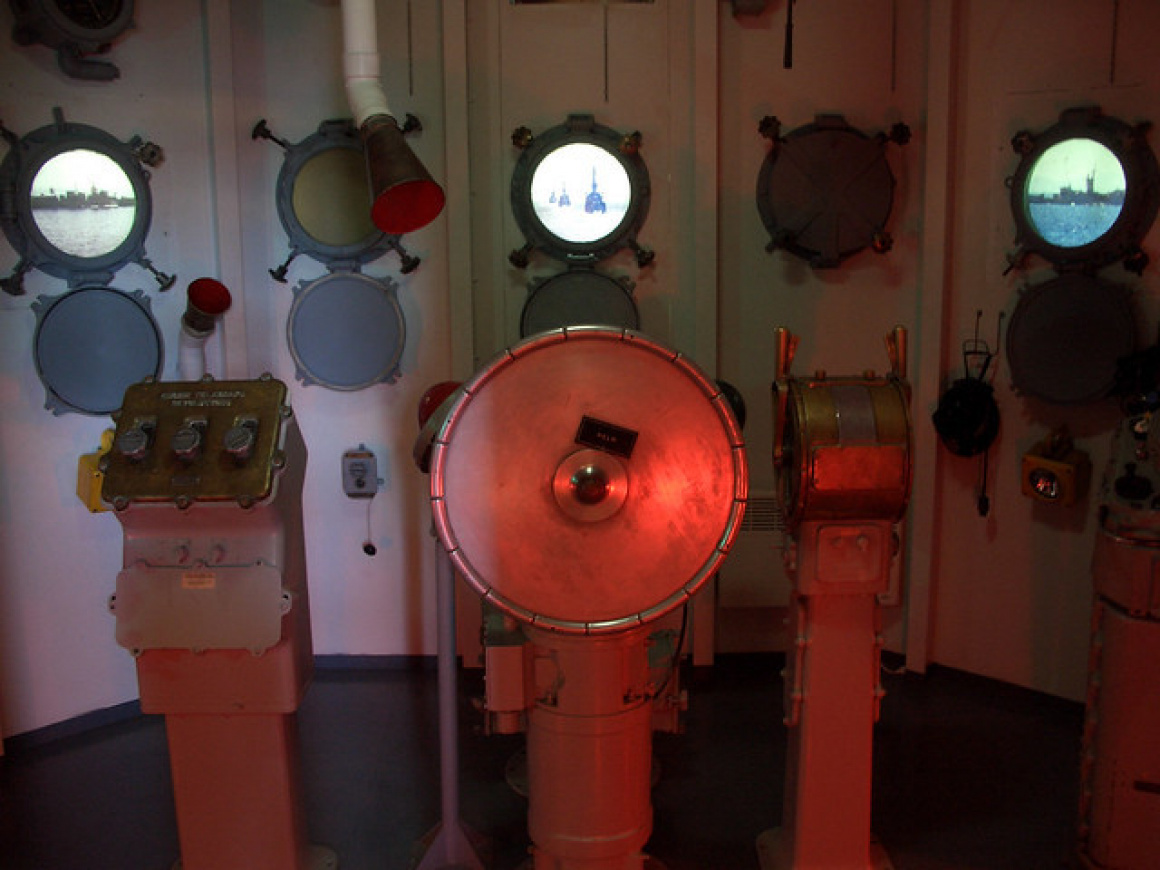
 'Destroyer control room mock-up' - Attribution: currybet
'Destroyer control room mock-up' - Attribution: currybetInteractive/Multimedia
Although traditional in many respects, the museum does incorporate some audiovisual elements. There are possibly short documentary loops of historic naval footage or digital screens where visitors can explore maps or the anatomy of ships. One reported feature is a ship simulator or periscope. To engage children, some dioramas are also present: one depicts the Battle at Gramvousa during the 1820s, with little figures on ships and a fort, while another shows ancient ships in a harbour.
Exiting through the gift shop, you'll find souvenirs such as model ships, books on naval battles, and even Cretan sea salt or shell jewellery. Although the shop is moderate in size, it offers unique items, like vintage naval map posters that many visitors admire.
Visiting Tips
The museum is conveniently located at the end of the harbour – after you walk past the old port with its tavernas and the lighthouse view, you find it by the fortress. Combining a visit with a stroll in the Firkas Fortress yard (which is free to enter and offers a great harbour view) is highly recommended. The iconic “Eighteen Englishmen Bastion” (where British cannon were used in WWII) is part of the same complex, and you might see it as you enter. It usually opens daily, except on some holidays, with summer hours approximately from 10am to 6pm, and shorter hours in winter. Tickets are around €4 (with discounts available). Although it's a quick visit if you skim, allow at least 1 hour – or easily 1.5 hours if you enjoy reading the detailed labels, such as one describing a Cretan ship that fought at Salamis in 480 BC.
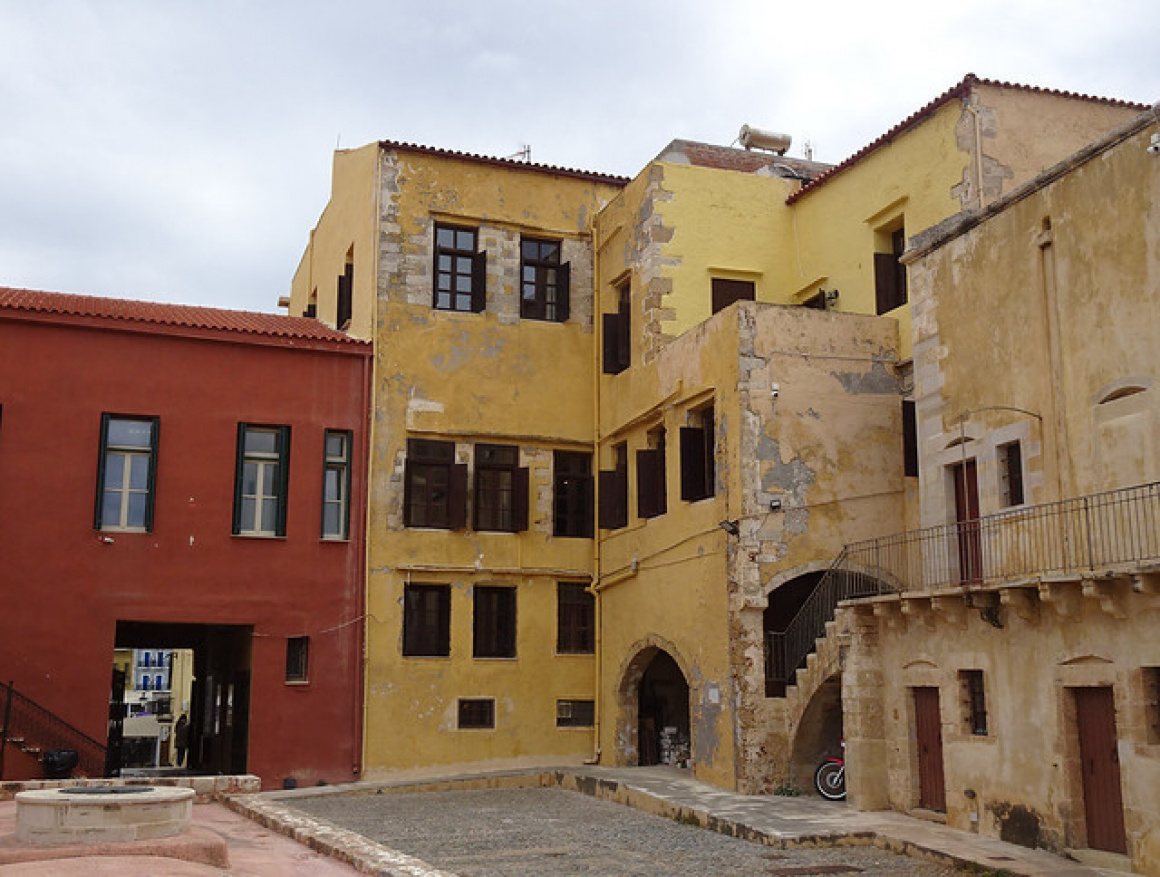
 'Courtyard - Maritime Museum' - Attribution: mikecogh
'Courtyard - Maritime Museum' - Attribution: mikecoghFor families, kids often love the model ships and the actual torpedoes and naval mines on display (there is even a real WWII naval mine outside the museum entrance, painted red – a popular photo spot). The museum also has a dedicated section for children with interactive games like knot-tying or signal flag puzzles, which are common in maritime museums. It's also a calm indoor retreat if it gets too hot outside, as there is air-conditioning.
If you plan to take the Chania harbour boat tour or the glass-bottom boat, doing the Maritime Museum before or after enriches that experience – you'll appreciate the Venetian lighthouse and walls more, understanding the strategy behind them from the museum's content. Additionally, if you visited the Historical Museum of Crete in Heraklion and liked the WWII parts, you'll find some continuation here with more military hardware. Conversely, if you start here, you might consider visiting the small War Shelter of Platanias or a site like Maleme if you want more WWII context on Crete. Temporary exhibits are also sometimes hosted – a past one focused on Ancient shipwrecks of Crete with items loaned from the Heraklion museum, and another on “Sea Creatures of Crete” linking to marine biology. Check if there are any current ones for a bonus.
Remember to check the annex: the museum has an additional section in a historic Venetian stone building (the Firka barracks), where one floor is dedicated to maritime exhibits and the upper floor may hold the war museum collection. Ensure you visit both levels so you don't miss half the display.
Finally, photography (without flash) is allowed, and you can capture lovely shots of the miniature ships crafted by local modelmakers with painstaking accuracy. It's a living tradition, and on occasion, you might even meet one of the craftsmen demonstrating their skills in a side room.
Why It Matters
By visiting the Maritime Museum of Crete, you gain insight not only into naval battles or ship types, but also into Crete's identity as an island. For centuries, control of Crete meant control of Eastern Med sea lanes. The exhibits illustrate how Cretans have been both subjects and shapers of sea history – from the Minoan Thalassocracy (rule of the sea) to the courageous sailors ferrying weapons to resistance fighters in 1941. It resonates when you next look at Chania's harbour: the waters where Venetian galleys docked, Ottoman warships anchored, and Allied warships attempted to hold against the Axis. The sea is a constant, but technology and empires changed – a story well captured by the museum.
Also, Crete has a strong naval connection to modern Greece – Souda Bay (near Chania) is Greece's largest naval base now, often hosting international exercises. The museum subtly connects that present (it might have a photo of a modern frigate in Souda) with 3000 years of maritime tradition.
For someone exploring Crete beyond its beaches, this museum stands out as a cultural gem. It's often rated highly by visitors and is lovingly maintained by retired Navy officers who curate it, ensuring authenticity and passion. You might learn an interesting fact – perhaps about the ancient port of Phalasarna on west Crete, with its ingenious ship sheds, or about how Cretan sailors once captured a submarine in WWII. And you'll sense the pride of Crete's maritime legacy.
When you leave, consider walking onto the ramparts of Firkas Fortress, located right adjacent to the museum (partially accessible), where a Greek flag flies. It was here on 1 December 1913 that the Greek flag was raised to signal Crete's union with Greece – a historic naval salute occurred in the harbour. The museum covers that event too, with photos of Venizelos and King Constantine at Firkas. Standing there, overlooking the sea and the lighthouse after absorbing the museum's narrative is a moving finale – you truly feel the weight of all that history converging in one view.


